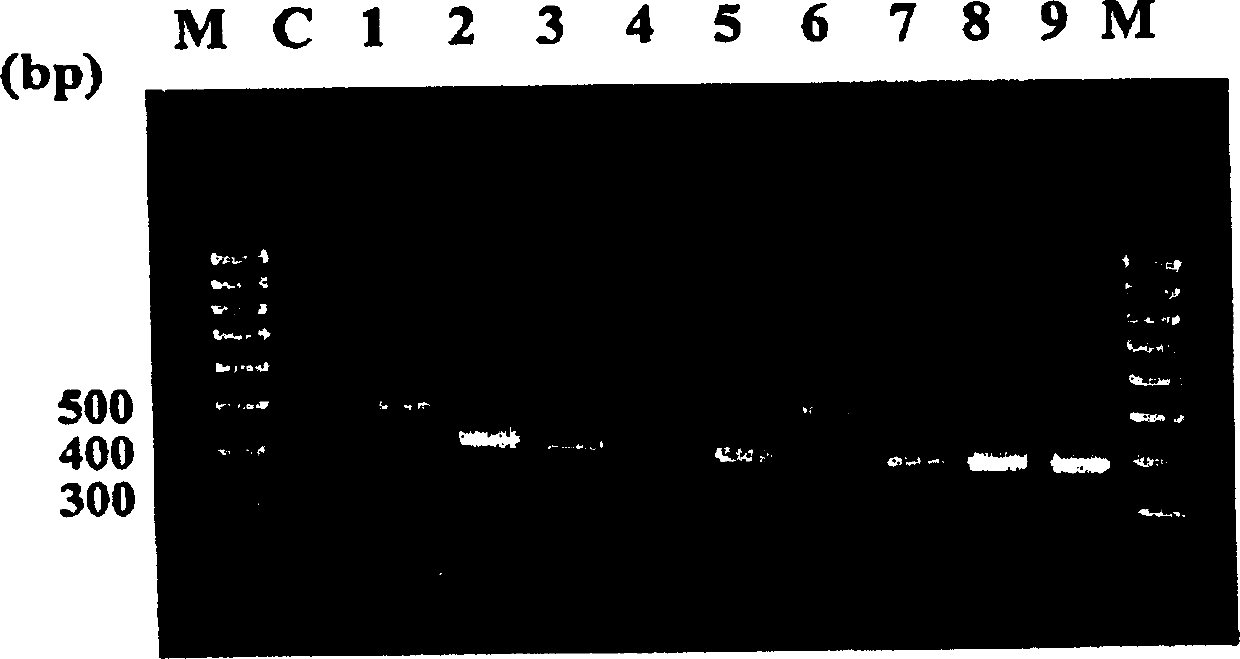Oligonucleotide for detection and identification of mycobacteria
A technology of oligonucleotides and mycobacteria, which is applied in the field of oligonucleotides for detection and identification of mycobacteria, and can solve problems such as no distinction
- Summary
- Abstract
- Description
- Claims
- Application Information
AI Technical Summary
Problems solved by technology
Method used
Image
Examples
example 1
[0056] Example 1. Mycobacterium culture and genomic DNA isolation
[0057] The standard strains of mycobacteria are derived from KCTC (Korea Model Collection) and ATCC (American Model Collection), and clinical strains are from the Korean National Tuberculosis Association, National Masan Tuberculosis Hospital, and clinical microbiology experts from Pusan National University Hospital Manage the storage and cultivation of strains. The mycobacteria and pathogens used in the examples are listed in Table 8.
[0058] The extraction process of mycobacterial DNA is as follows: culture mycobacteria with Ogawa medium. Then place the cultured bacteria in a platinum ring in a microcentrifuge tube, mix with 200 μl of InstaGene substrate (Bio-Rad Co.), and incubate at 56°C for 30 minutes. After another 10 minutes of vortex mixing, the mixture was placed at 100°C for 8 minutes. After another 10 minutes of vortex mixing, the mixture was centrifuged at 12,000 rPM for 3 minutes. Take the supernata...
example 2
[0059] Example 2. Amplify mycobacterial ITS to make primers
[0060] The mycobacterial ITS and the primers used to amplify the ITS by PCR are listed in Figure 1. The primers for amplifying the ITS of mycobacteria were constructed based on several fragments of the conserved regions of 16SrRNA and 23SrRNA of mycobacteria. The DNA sequences of 16SrRNA and 23SrRNA of Mycobacterium from the gene bank were analyzed by multiple sequence comparison and immature cell inspection. Then, primers were designed by part of the DNA of 16SrRNA and 23SrRNA, so that about 500bp of ITS region can be selectively placed. The DNA sequences of these primers are listed in SEQ ID NOs: 242 (IT SF) and 243 (ITSR). All the primers used in this example were prepared by Derkin-Elmer DNA Synthesizer (BioBasic, Canada) with a concentration of 50 nmol.
example 3
[0061] Example 3. PCR and product identification
[0062] In PCR, 2 μl of the DNA solution in Example 1 was used. The reaction solution includes: 500mM KCl, 100mM Tris HCl (pH9.0), 1% Triton X-100, 0.2mM dNTP (dATP, dGTP, dTTP and dCTP), 1.5mM MgCl 2 , 1pmol primer, 1μTag DNA polymerase (Bio Basic Inc.). After denaturation at 94°C for 5 minutes, the solution was denatured at 94°C for 1 minute, annealed at 60°C for 1 minute and 72°C for an extension of 1 minute and circulated 30 times. A further extension of 72°C for 10 minutes ensures that the extension is over. After the reaction, the PCR product was identified by 1.5% agarose gel electrophoresis. As predicted from GenBank data, the ITS amplified by the primers prepared from the conserved regions of 16S rRNA and 23S rRNA was about 500 bP.
[0063] Figure 2 is a photograph of the electrophoresis result after PCR. PCR uses several mycobacterial strains and a pair of ITS amplification primers, including a part of mycobacterial 16S r...
PUM
 Login to View More
Login to View More Abstract
Description
Claims
Application Information
 Login to View More
Login to View More - R&D
- Intellectual Property
- Life Sciences
- Materials
- Tech Scout
- Unparalleled Data Quality
- Higher Quality Content
- 60% Fewer Hallucinations
Browse by: Latest US Patents, China's latest patents, Technical Efficacy Thesaurus, Application Domain, Technology Topic, Popular Technical Reports.
© 2025 PatSnap. All rights reserved.Legal|Privacy policy|Modern Slavery Act Transparency Statement|Sitemap|About US| Contact US: help@patsnap.com



